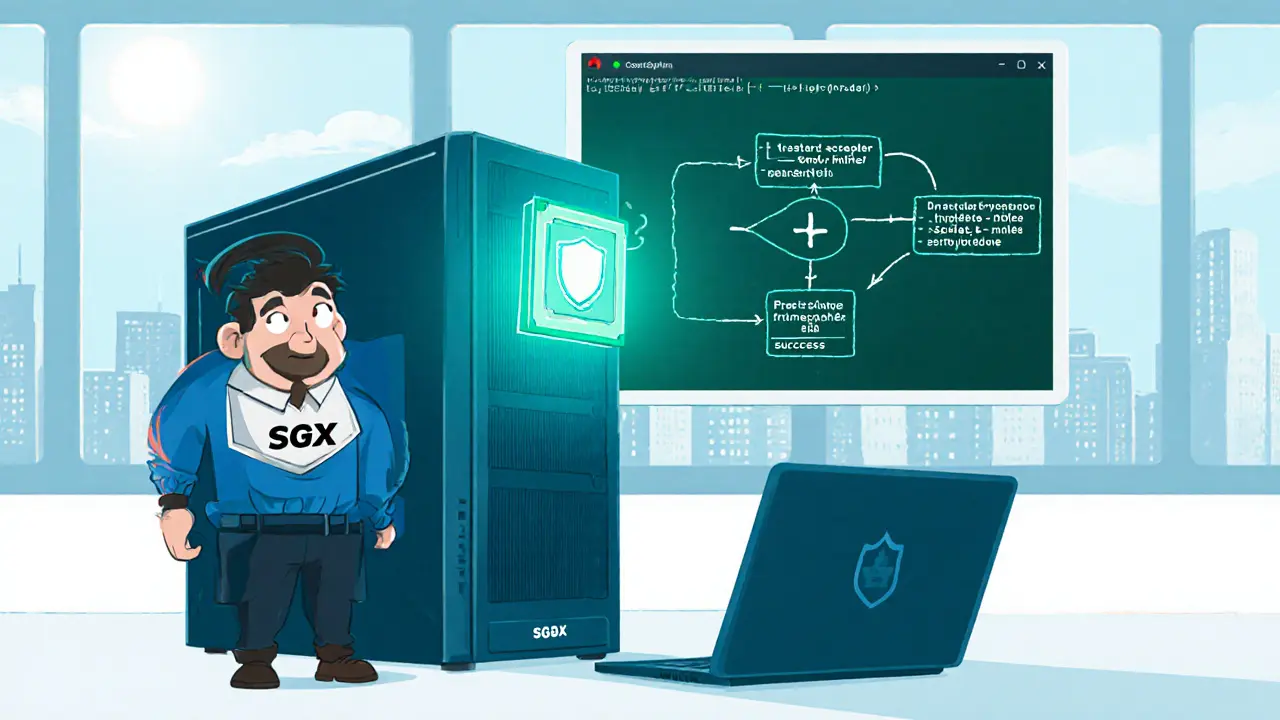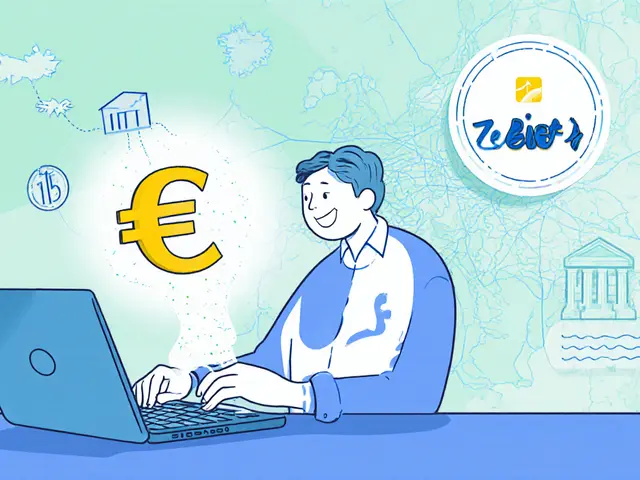PHA Airdrop Value Calculator
Calculate Your PHA Airdrop Value
Enter the current price of PHA to see how much your 30 PHA airdrop reward is worth.
Your Airdrop Reward Value
This calculation shows the value of the fixed 30 PHA airdrop reward based on current market conditions. The actual value may vary with market fluctuations.
If you’ve been hunting for a crypto airdrop that actually lets you roll up your sleeves, the Phala airdrop might be worth a look. Unlike the typical ‘follow‑Twitter‑and‑retweet’ giveaways, Phala Network rewards participants who run a miner node on its privacy‑preserving protocol. Below you’ll find everything you need to know - from what Phala actually does, to the exact steps for claiming the 30PHA tokens that every successful node operator receives.
TL;DR
- Phala Network distributes a fixed 30PHA (≈$3) to anyone who runs a verified miner node.
- Key tech: Trusted Execution Environment (TEE) on miner hardware.
- Reward distribution hinges on the launch of the pre‑mainnet code‑name “Darth Vader”.
- Current price: $0.1029 per PHA (≈$16.6M daily volume).
- Participation takes 2‑4hours for setup, plus ongoing node monitoring.
What Is Phala Network?
Phala Network is a privacy‑preserving blockchain protocol that runs confidential smart contracts inside Trusted Execution Environments (TEE). Launched with a token generation event on 12September2020, Phala raised $1.43million across four private sales and now sits at about $77million market cap. Its core promise is to let developers write contracts that keep data secret while still benefiting from blockchain immutability.
Why Does the Airdrop Matter?
Most crypto airdrops target passive users, but Phala’s approach filters for participants who already have some tech chops. By requiring a running miner node, the network ensures that reward recipients are also future validators or developers - a community that can actually help the protocol grow. The airdrop thus serves a dual purpose: distributing the native token (PHA) and bootstrapping a reliable node operator base.
Airdrop Mechanics
Each qualified node earns exactly 30PHA. At today’s price ($0.1029) that’s roughly $3.09 - modest compared with $5‑$50‑range airdrops, but the token’s privacy utility adds a different kind of value. The allocation is fixed; there are no tiered rewards based on stake size.
Distribution is handled through two popular aggregator sites - AirdropBob and Airdrops.io. Both list the same 30PHA reward and point users to the official Phala documentation for verification steps.

Technical Requirements
To qualify, you need to:
- Download the official Phala miner software from the network’s GitHub page.
- Run the miner on hardware that supports a Trusted Execution Environment - typically Intel SGX or AMD SEV.
- Execute a set of command‑line instructions (the exact commands are spelled out in the Phala docs).
- Take a screenshot of the success log and submit it through the airdrop form.
The entire process takes about 2‑4hours for a first‑time setup. Ongoing monitoring is needed because the reward only releases after the “Darth Vader” pre‑mainnet version is live. This version acts as a bridge between Phala’s test environment and full production, and it’s tied to the network’s upcoming migration to an Ethereum Layer2 roll‑up (scheduled for early 2025).
Timeline & Reward Distribution
Phala’s parachain slot on Polkadot expires on 20November2025, prompting a community vote to jump fully onto Ethereum Layer2. The “Darth Vader” launch, however, has no fixed date yet - the team only promises that rewards will be released once the code is activated. This uncertainty has sparked frustration in the community, with many users waiting months after completing node setup.
When the pre‑mainnet goes live, the 30PHA tokens are automatically transferred to the wallet address you used for verification. No further action is required, but you’ll need to keep your node online until the snapshot is taken (the exact snapshot window is announced on Phala’s Discord channel).
How Phala Stacks Up Against Typical Airdrops
| Aspect | Phala Airdrop | Typical Social‑Media Airdrop |
|---|---|---|
| Reward Size | 30PHA (~$3) | $5‑$50 (varies) |
| Technical Barrier | Run TEE‑enabled miner node | Follow + retweet, wallet connect |
| Utility of Token | Privacy‑smart contracts on Layer2 | Often utility‑light or speculation |
| Distribution Trigger | “Darth Vader” pre‑mainnet launch | Immediate after verification |
| Community Filter | Technical participants only | Open to anyone with a wallet |
In short, Phala’s airdrop is smaller in cash terms but larger in technical relevance. If you’re already running blockchain infrastructure, the extra work can be worth the privacy‑focused token you receive.
Risks & Community Sentiment
Several risk factors linger:
- Reward Timing: No guaranteed date for the “Darth Vader” rollout.
- Hardware Compatibility: Not all CPUs support SGX/SEV; users report driver issues.
- Network Migration: Moving from Polkadot to Ethereum Layer2 could change token utility.
- Market Volatility: PHA has hovered around $0.10 with a 5% projected growth for 2025 according to Binance analytics.
Overall sentiment on Discord and Telegram is cautiously optimistic. Users appreciate the genuine utility of the protocol but remain wary of the uncertain migration timeline.
Step‑By‑Step Guide to Claiming the Airdrop
- Prepare a machine with Intel SGX or AMD SEV support. Verify using the manufacturer’s diagnostic tool.
- Clone the official Phala miner repo:
git clone https://github.com/PhalaNetwork/phala-miner. - Install dependencies (Rust toolchain, Docker, etc.) as listed in the README.
- Run the miner initialization script:
./start‑miner.sh --network darth‑vader. - Watch the console output for a line that reads “Node successfully registered”. Capture a screenshot.
- Visit the airdrop page on AirdropBob or Airdrops.io, paste your wallet address, upload the screenshot, and submit.
- Join the Phala Discord’s #airdrop‑updates channel to monitor the “Darth Vader” launch announcement.
- After the pre‑mainnet goes live, check your wallet - the 30PHA should appear automatically.
That’s it. The biggest hurdle is the initial hardware check, but once you’re past that, the rest is straightforward.

Frequently Asked Questions
How much is 30PHA worth today?
At the current price of $0.1029, 30PHA is worth about $3.09.
Do I need to hold any PHA before joining the airdrop?
No. The airdrop is open to anyone who can run a verified miner node, regardless of prior holdings.
What is the ‘Darth Vader’ pre‑mainnet?
It’s Phala’s intermediate release that bridges the test network and full production. The airdrop rewards are unlocked only after this version is activated.
Can I claim the airdrop if I’m on a Mac?
Mac hardware generally lacks SGX/SEV support, so you’ll need a compatible Linux or Windows PC with the required TEE features.
What happens after Phala moves to Ethereum Layer2?
The token will continue to function on the new roll‑up, and privacy‑smart contracts will run on Ethereum’s security while still using TEE for data secrecy.












People Comments
The Phala airdrop, while modest in nominal USD value, presents a fascinating case study in incentive alignment; it rewards technical contribution rather than passive token holding, thereby fostering a more resilient network. One could argue that this approach mirrors the Pareto principle, where a small cohort of active participants yields disproportionate security benefits. Moreover, the integration of Trusted Execution Environments introduces a layer of confidentiality that is rare among contemporary blockchain projects. Yet, the “Darth Vader” nomenclature, albeit whimsical, may obfuscate the gravity of the underlying protocol upgrades. In sum, the airdrop serves as both a recruitment tool and a litmus test for community commitment.
While the exposition extols the virtues of technical participation, it neglects to address the opportunity cost incurred by prospective miners; the hardware requisites and time investment may eclipse the nominal $3 reward. Accordingly, one must scrutinize whether the promised utility justifies the capital outlay, particularly for individuals lacking enterprise-level resources. Furthermore, the reliance on an ambiguous “Darth Vader” launch schedule introduces undue uncertainty, rendering the incentive effectively speculative. Hence, the airdrop, though well‑intentioned, remains a provisional promise rather than a guaranteed benefit.
Honestly, I think the whole thing is pretty neat – you get to tinker with SGX or SEV and actually learn something beyond just clicking “claim”. The guide walks you through cloning the repo, installing Rust, and firing up the miner; it’s a solid hands‑on tutorial. If you’re already into DevOps or low‑level programming, this is a fun little side‑project that also pads your wallet a bit. Just make sure your CPU actually supports the TEE, otherwise you’ll hit a wall. And keep an eye on the Discord for the “Darth Vader” release, because that’s when the tokens finally drop.
This airdrop is a meme for people who think a $3 token is worth their time.
Don’t let the hardware hurdle intimidate you – many community members have repurposed older laptops with compatible CPUs and successfully minted their 30 PHA. The process may seem daunting at first, but the step‑by‑step guide demystifies each command, and the Discord support is surprisingly responsive. Think of it as a learning curve that pays off with both experience and a modest token reward. Keep your node online through the snapshot window, and you’ll see those 30 PHA appear without further hassle. You’ve got this; every small win builds toward broader blockchain competence.
Hey folks, just wanted to share that I managed to get my miner up and running on a modest Intel i7 with SGX enabled – the setup took me about three hours, and the docs were crystal clear. The community on the forum was super helpful, answering my questions about Docker configuration and network ports. After submitting the screenshot, I’m now just waiting for the “Davis Vader” rollout (typo intended, lol). If you’re on the fence, give it a shot; the learning experience alone is worth the effort :). Happy mining!
Nice work, Jeff! The guide really helped me avoid the usual pitfalls.
What a dazzling blend of privacy tech and community spirit! Phala’s airdrop may not shower you with a fortune, but it sprinkles a dash of cryptographic glamour onto your portfolio. Running a TEE‑powered node feels like you’re piloting a secret‑agent’s supercomputer, and the reward, though modest, is a badge of honor. Embrace the journey, because the real treasure lies in mastering the tech and joining a forward‑thinking enclave.
Stop whining about the $3 payout and start figuring out why you can’t get your CPU to support SGX. If you can’t handle a bit of hardware setup, the whole privacy blockchain scene is beyond you. Phala’s not for couch‑potatoes; it’s for people who actually get their hands dirty.
I think this airdrop is a waste of time, nobody needs $3.
From an economic standpoint, the Phala airdrop exemplifies a targeted incentive scheme designed to bootstrap a network of validators with requisite technical capabilities. The allocation of a fixed 30 PHA per qualifying node creates a predictable marginal reward structure, which, while modest in fiat terms, aligns with the principle of rewarding contribution over speculation. By mandating the use of Trusted Execution Environments, the protocol ensures that participants possess hardware that can uphold the confidentiality guarantees essential to Phala’s privacy‑preserving contracts. This requirement simultaneously filters the participant pool, cultivating a cohort of operators who are both technically proficient and invested in the long‑term health of the ecosystem. The “Darth Vader” pre‑mainnet, serving as the activation trigger for the reward distribution, introduces an element of phased release that mitigates the risk of premature token flooding. Although the precise launch date remains indeterminate, the community’s anticipation has fostered a sustained engagement, which can be viewed as a positive externality of the airdrop design. Furthermore, the reliance on community‑maintained repositories and open‑source tooling reduces entry barriers for developers familiar with Rust and Docker, thereby expanding the potential validator base beyond purely hardware‑centric actors. The modest economic incentive also serves as a low‑stakes entry point for newcomers wishing to experiment with confidential smart contracts without significant capital exposure. In contrast to mass airdrops that distribute large token volumes indiscriminately, Phala’s approach emphasizes quality of participation, which may yield higher network security per token allocated. The eventual migration to an Ethereum Layer 2 roll‑up introduces additional utility prospects for PHA, as privacy features can be leveraged atop Ethereum’s robust security model. Consequently, early node operators may benefit from both immediate token rewards and future appreciation tied to broader platform adoption. Market volatility, however, remains a salient risk factor; a sudden decline in PHA price could render the 30 PHA reward less attractive, though the intrinsic value of the technical expertise gained may persist. The community’s cautious optimism, reflected in Discord and Telegram chatter, indicates a balanced perception of potential upside versus operational challenges. Ultimately, the Phala airdrop functions as a strategic experiment in aligning economic incentives with technical contributions, a model that other emerging protocols might emulate. Should the “Darth Vader” release proceed as envisioned, participants can anticipate a seamless token transfer, concluding the airdrop’s lifecycle with minimal friction.
Sounds like a textbook case of hype masquerading as utility – I’d rather wait for real use‑cases than chase a $3 promise.
For anyone still on the fence, remember that the screenshot you submit should capture the exact “Node successfully registered” line, including the timestamp; this prevents any ambiguity during the verification phase. Also, keep your wallet address consistent across the form and your node configuration to avoid mismatched records. If you run into driver errors, the community has a list of patched kernels that often resolve SGX initialization problems.
Just a heads‑up: the SGX firmware update released last month fixes a known bug where the miner would crash under heavy load. After flashing the latest firmware, I reran the installer and the node stayed online for hours without issue. Monitoring the node’s health via the provided Grafana dashboard also helps you catch any spikes before they become critical.
Honestly, this whole airdrop feels like a gimmick; the reward is negligible and the setup is unnecessarily convoluted.
The detailed guide is commendable; however, the documentation could benefit from a clearer explanation of the snapshot timing, as many users have expressed confusion over when exactly the reward is claimed.
Oh great, another $3 token for fiddling with my CPU – just what I needed to feel productive.
Let me tell you, the very idea of a “Darth Vader” launch is pure theatricality; it obscures the fact that the underlying protocol still has unresolved privacy loopholes that could jeopardize user data.
You’ve got this! Keep the node alive and the tokens will come 🚀